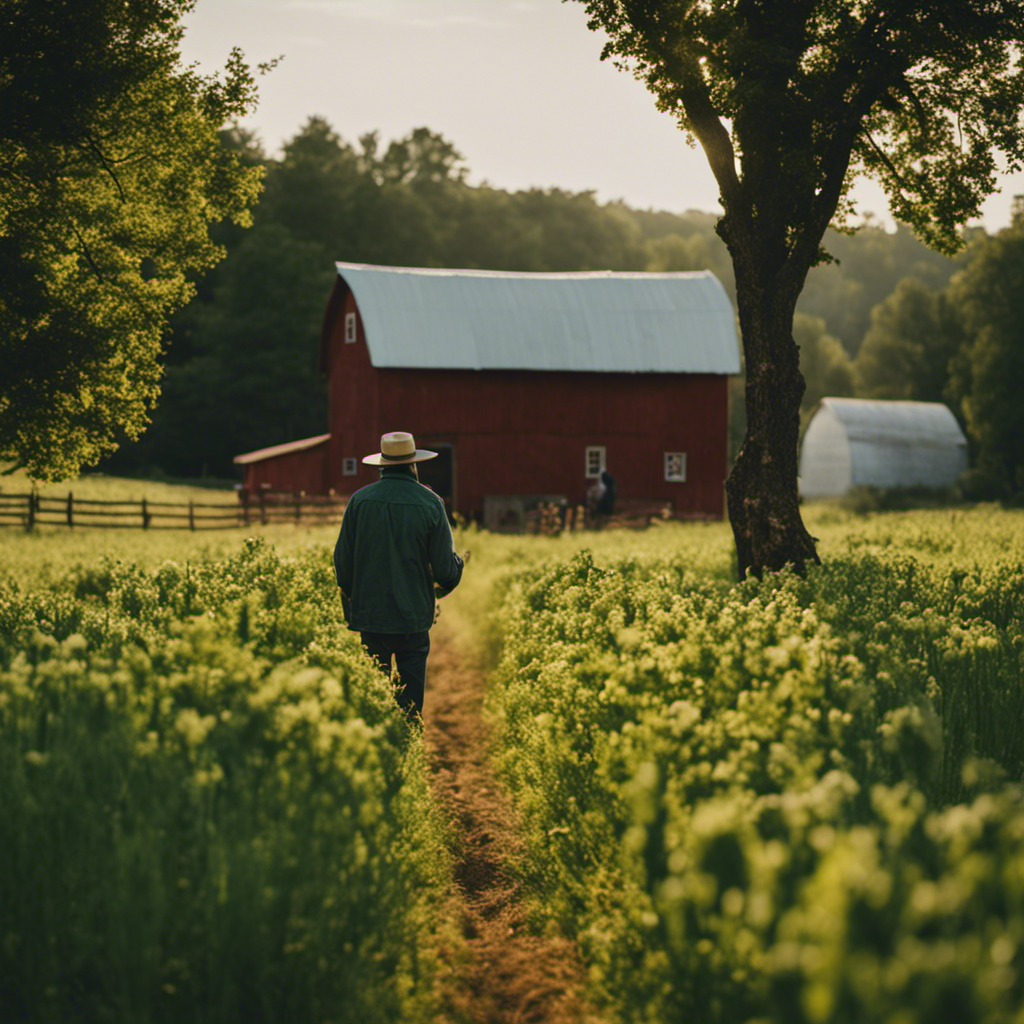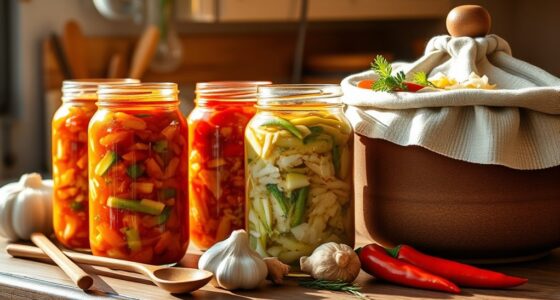We recognize your goal is to cultivate the perfect fruit tree, and we possess the essential steps needed to make it happen!
In this article, we’ll guide you through the process of selecting the right varieties, understanding soil requirements, preparing the planting site, and more.
With our expert tips and tricks, you’ll learn how to water, fertilize, prune, and protect your tree against pests and diseases.
Get ready to harvest and store your delicious fruits with confidence.
Let’s dive in!
Key Takeaways
- Research and experiment with different fruit tree varieties, considering disease-resistant options for reduced chemical interventions
- Understand the pollination requirements and soil requirements of fruit trees
- Clear the planting area of debris, rocks, and weeds, and loosen the soil and incorporate organic matter
- Select a location with at least six hours of direct sunlight daily, ensure well-drained soil, and plant at the recommended distance for proper air circulation
Selecting the Right Fruit Tree Varieties
We should research and experiment with different fruit tree varieties to ensure we’re selecting the right ones for our needs.
It’s crucial to consider disease resistant options and pollination requirements when choosing fruit trees. Disease-resistant varieties are important because they’ve built-in resistance to common pests and diseases, reducing the need for chemical interventions. This not only benefits the health of the trees but also the environment.
Additionally, understanding the pollination requirements of fruit trees is essential for successful fruit production. Some fruit trees require cross-pollination, meaning they need another compatible variety nearby for pollination. Others are self-pollinating and only need one tree to produce fruit.
Understanding Soil Requirements
Our success in fruit tree cultivation relies heavily on understanding the soil requirements for optimal growth and fruit production. Soil composition plays a crucial role in providing the necessary nutrients and water for the trees.
Here are three key factors to consider:
-
pH Balance: Different fruit trees thrive in different soil pH levels. It’s important to know the ideal pH range for your chosen fruit tree and adjust the soil accordingly.
-
Nutrient Content: Fruit trees have specific nutrient requirements for healthy growth and fruit production. Conducting soil tests regularly will help determine the nutrient deficiencies and allow for proper nutrient management.
-
Drainage and Texture: Good soil drainage is essential to prevent waterlogging, which can harm the roots. Additionally, the soil texture affects the tree’s ability to uptake water and nutrients effectively.
Understanding these soil requirements will lay the foundation for successful fruit tree cultivation.
Now, let’s move on to preparing the planting site to ensure the best start for our trees.
Preparing the Planting Site
There are several steps we need to take, such as clearing the area and loosening the soil, in order to prepare the planting site for our fruit trees.
Soil preparation is crucial for the successful cultivation of fruit trees. Firstly, we must clear the area of any debris, rocks, or weeds that may hinder the growth of our trees.
Next, we need to loosen the soil to improve its drainage and aeration. This can be done by tilling or using a garden fork.
Additionally, incorporating organic matter such as compost or well-rotted manure into the soil will provide essential nutrients for the trees’ growth.
Mulching techniques can also be employed to retain moisture, suppress weed growth, and regulate soil temperature. Applying a layer of organic mulch around the base of the trees will help conserve water and prevent soil erosion.
With proper soil preparation and mulching techniques, we can create an optimal environment for our fruit trees to thrive.
Planting the Fruit Tree
After we’ve prepared the planting site, it’s important to choose the right location for our fruit tree, as this will greatly impact its growth and productivity. Here are some key considerations for planting our fruit tree:
-
Sunlight: Select a location that receives at least six hours of direct sunlight daily. This ensures optimal photosynthesis and fruit production.
-
Drainage: Ensure the chosen spot has well-drained soil to prevent waterlogging, which can lead to root rot and poor growth.
-
Proper Tree Spacing: Plant the fruit tree at the recommended distance from other trees or structures. This allows for proper air circulation and prevents competition for nutrients.
To enhance the tree’s growth and health, we should also implement mulching techniques. Applying a layer of organic mulch around the base of the tree conserves soil moisture, suppresses weeds, and regulates soil temperature.
Watering and Fertilizing Techniques
As we continue discussing watering and fertilizing techniques, it is important to consider the specific needs of our fruit tree to ensure its proper growth and development. When it comes to watering, using drip irrigation has proven to be highly effective. This method delivers water directly to the roots, minimizing waste and evaporation. Additionally, it is crucial to choose the right fertilizers for our fruit tree. Organic fertilizers provide essential nutrients without harmful chemicals, promoting healthy growth and improving soil fertility. To further engage our audience, let’s take a look at a table summarizing the benefits of drip irrigation and organic fertilizers:
| Drip Irrigation | Organic Fertilizers |
|---|---|
| Reduces water waste | Enhances soil fertility |
| Minimizes evaporation | Promotes healthy growth |
| Delivers water directly to roots | Provides essential nutrients |
Pruning and Training the Tree
Once we understand the importance of pruning and training the tree, we can effectively shape its growth and optimize fruit production. Pruning techniques and training methods play a crucial role in maintaining the health and productivity of fruit trees.
Here are three essential steps to consider:
-
Regular pruning: Pruning helps remove dead or diseased branches, allowing the tree to allocate energy to healthy growth. It also encourages proper air circulation and sunlight penetration, reducing the risk of fungal diseases.
-
Training young trees: Properly training young trees ensures a strong and balanced framework for future growth. This involves selecting a central leader or main trunk and removing competing branches to maintain an open canopy structure.
-
Renewal pruning: Over time, fruit trees may become unproductive or overgrown. Renewal pruning involves selectively removing old branches to stimulate new growth and rejuvenate the tree.
Protecting Against Pests and Diseases
We need to regularly inspect our fruit trees for pests and diseases, and take immediate action to protect them, so that we can ensure a healthy and productive harvest. By implementing natural pest control methods and choosing disease resistant varieties, we can minimize the risk of infestation and disease outbreak.
One effective natural pest control method is attracting beneficial insects, such as ladybugs and lacewings, which feed on pests like aphids and mites. Additionally, planting companion plants like marigolds and garlic can repel certain pests.
Disease resistant varieties, on the other hand, are genetically bred to have increased resistance to common diseases.
Regularly monitoring our fruit trees for signs of pests and diseases, and promptly addressing any issues, is crucial to maintaining the health and productivity of our orchard.
Harvesting and Storage Tips
Let’s make sure to carefully handle the harvested fruits and store them in a cool and dry place to prolong their freshness and prevent spoilage. When it comes to fruit tree cultivation, proper harvesting and storage are crucial to ensure the best quality produce.
Here are some essential tips to help you with organic fruit storage:
-
Inspect for pests: Before storing the fruits, it’s important to check for any signs of fruit tree pests. Look out for holes, discoloration, or insect infestations. Removing damaged fruits will prevent the spread of pests and diseases.
-
Choose the right storage containers: Opt for breathable containers such as baskets or mesh bags to allow proper air circulation. Avoid using plastic bags, as they can trap moisture and lead to mold growth.
-
Find an ideal storage location: Store the fruits in a cool and dry place, away from direct sunlight. A temperature of around 50-60°F (10-15°C) is ideal for most fruits, while low humidity will prevent rotting.
Seasonal Maintenance for Long-Term Success
Regularly maintaining our fruit trees throughout the seasons is essential for long-term success in fruit tree cultivation. By following proper maintenance practices, we can ensure healthy growth, abundant yields, and ultimately, a bountiful harvest. One important aspect of maintenance is mulching, which provides numerous benefits such as conserving soil moisture, suppressing weed growth, and improving soil fertility. Another crucial consideration is pollination techniques, as proper pollination is vital for fruit set and development. To evoke emotion in our audience, let us take a closer look at the beneficial effects of mulching and the various pollination techniques employed in fruit tree cultivation.
| Mulching Benefits | Pollination Techniques |
|---|---|
| Conserves moisture | Hand pollination |
| Suppresses weeds | Insect pollination |
| Enhances soil fertility | Wind pollination |
Frequently Asked Questions
How Do I Know if My Fruit Tree Is Getting Enough Sunlight?
We can determine if our fruit tree is getting enough sunlight by observing signs of sunlight deficiency. These signs include stunted growth, sparse foliage, and poor fruit production.
Can I Plant Multiple Fruit Tree Varieties in the Same Area?
Yes, we can plant multiple fruit tree varieties in the same area. Companion planting offers benefits like cross pollination, resulting in improved fruit production. It’s a great way to maximize space and enhance the overall health of the orchard.
What Is the Best Time of Year to Plant a Fruit Tree?
The best time of year to plant a fruit tree is in the spring when the soil is warming up. It’s important to choose the best fruit tree varieties for beginners and avoid common mistakes when planting, like improper watering or planting too deep.
How Often Should I Water My Fruit Tree?
We water our fruit trees regularly to ensure optimal growth. Factors such as the tree’s age, weather conditions, and soil type determine its watering needs. Following proper watering techniques is essential for perfect fruit tree cultivation.
Are There Any Natural Methods to Prevent Pests and Diseases on Fruit Trees?
Yes, there are natural pest control methods available for organic fruit tree care. These methods include using beneficial insects, companion planting, neem oil, and homemade sprays made from ingredients like garlic and vinegar.
Conclusion
In just 9 simple steps, you can become the master of fruit tree cultivation.
From selecting the perfect varieties to understanding soil requirements, preparing the planting site, and mastering watering and fertilizing techniques, you’ll be on your way to a bountiful harvest in no time.
With proper pruning, training, and protection against pests and diseases, you’ll ensure the health and longevity of your trees.
Plus, with our harvesting and storage tips and seasonal maintenance guidance, you’ll enjoy long-term success as a fruit tree cultivator.
Start your fruitful journey today!










